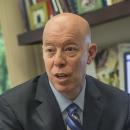Closing the Gap Between Youth and Police: Conference Launches Conversation, Solutions

Sometimes the most searing injustices register as a shoulder shrug, and sometimes they don’t get mentioned at all. Sometimes they’re written off as normal — even as they fuel a more visibly devastating flash point.
This was among the themes at a powerful two-day Law School conference that laid bare the painful truths, intractable challenges, and not-always-acknowledged realities of youth/police relations in a series of often-emotional sessions that brought together law enforcement officials, urban youth, advocates, and top scholars to candidly examine the day-to-day issues contributing to the growing national crisis in police/community relations. Among the major topics discussed: the routine interactions between police and minority urban youth that leave deep, lasting scars — “It just make you feel down, like you ain’t nobody,” one teen said — but are often written off as a simple fact of life.
“Distrust between black kids and police didn’t start in Ferguson,” Clinical Professor Craig Futterman, one of the event’s organizers, said near the beginning of the conference. “It’s been there for years. And it has done way too much damage — way, way, way too much damage — both to the black community and to police.”
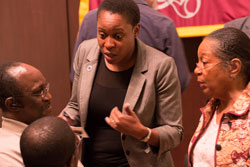 The Youth/Police Conference — organized by the Law School’s Civil Rights and Police Accountability Clinic and the Invisible Institute, a Chicago-based journalistic production company — will serve as a springboard for the development of concrete policy, advocacy, and research initiatives. The event, which often felt more like a community conversation than a typical academic conference, included heartfelt perspectives from urban youth who described strategizing their public movements to avoid encountering police, as well as from police determined to effect change but frustrated by the barriers they encounter. Participants were not always in agreement, and many of the conversations were, at their roots, about humanity’s deepest frailties: shame, fear, distrust, and denial.
The Youth/Police Conference — organized by the Law School’s Civil Rights and Police Accountability Clinic and the Invisible Institute, a Chicago-based journalistic production company — will serve as a springboard for the development of concrete policy, advocacy, and research initiatives. The event, which often felt more like a community conversation than a typical academic conference, included heartfelt perspectives from urban youth who described strategizing their public movements to avoid encountering police, as well as from police determined to effect change but frustrated by the barriers they encounter. Participants were not always in agreement, and many of the conversations were, at their roots, about humanity’s deepest frailties: shame, fear, distrust, and denial.
“By bringing together people who are not typically in the same conversation and engaging them with the knowledge and experience of the young people most affected by urban police practices, the conference generated ideas to improve our practices around the nation,” Futterman said. “I don’t know if I have ever been in a more engaging conversation in which people who normally walk in such different spheres were really listening to and learning from one another. It was simply phenomenal.”
The more than 300 people who attended the conference challenged each other to answer tough questions: Who are the police really serving? How can you expect to change a system if you don’t understand how it works? How can you train implicit bias out of someone if you don’t force them to confront the shame of having the bias? By the end of the conference, the group had begun to search for solutions, a process that will continue unfolding in coming months.
“Now the challenge is to sustain the conversation,” said co-organizer Jamie Kalven, a writer and human rights activist with the Invisible Institute. “Toward that end, we're creating means for those who participated to remain engaged. Videos of the panel conversations will be posted online. We're preparing a multimedia report that will frame issues surfaced during the conference, as well as capture the concrete policy, research and advocacy agendas that emerged. And we'll continue to report on the themes of the conference.”
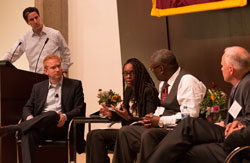 The conference grew from the Youth/Police Project, an ongoing social research initiative by Futterman’s clinic and the Invisible Institute. The project, started in 2011, has brought attorneys, journalists, academics, and community activists together with teenagers living on the South and West sides of Chicago. Through interviews and role-playing, the teenagers have shared their experiences with police and researchers, and recounted how those experiences affect and shape their thinking and behavior.
The conference grew from the Youth/Police Project, an ongoing social research initiative by Futterman’s clinic and the Invisible Institute. The project, started in 2011, has brought attorneys, journalists, academics, and community activists together with teenagers living on the South and West sides of Chicago. Through interviews and role-playing, the teenagers have shared their experiences with police and researchers, and recounted how those experiences affect and shape their thinking and behavior.
Throughout the conference, there were references to Michael Brown and Eric Garner, but the real focus was on these routine interactions between police and urban youth.
“The press likes to put the frame, ‘crisis’ around the major ongoing stories, but it doesn’t really fit to describe this phenomena across the country right now,” Kalven said. “It’s not a departure from the norm. What we’re seeing is the norm. What we’re seeing are fundamental features of our society that we’ve managed to live with but not see. What we’re seeing are harms that fall on some of our fellow citizens but not others. What we’re seeing is the sense that there are two constitutions — it means one thing where I’m standing right now and something quite different a few blocks from here.”
‘It Just Is What It Is’
During one of the panels, Tytania Holliman, a student at Hyde Park Academy who has worked with the Youth/Police Project, read a list of avoidance strategies youth use to avoid being stopped by police, one filled with contradictions: “Don’t walk alone,” she started. “Don’t walk in groups. Don’t make eye contact. Don’t look away too quickly. Don’t move too fast. Don’t linger. Don’t do anything. Don’t do nothing.”
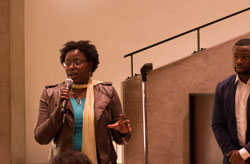 The examples flowed throughout the conference: youth so used to being questioned by police that they pull their ID cards out before being asked; a mother of four who told the audience that she was “as much afraid of the police as she was of the gangs,” young people who said they wouldn’t call the police, even if they needed help.
The examples flowed throughout the conference: youth so used to being questioned by police that they pull their ID cards out before being asked; a mother of four who told the audience that she was “as much afraid of the police as she was of the gangs,” young people who said they wouldn’t call the police, even if they needed help.
“There is so much stuff that young people need to carry around in their heads just to get down the street,” said Forrest Stuart, UChicago Assistant Professor of Sociology. The unwillingness to call police is a “fundamental issue in our democracy,” he said. “Perhaps we can use this as a measure for whether police are doing the job — whether people are willing to call.”
These stories are facts of life in many neighborhoods, where “it just is what it is,” members of the Youth/Police Project said.
“We ran into some early problems because (the high school students) thought we only wanted to hear the big stories — the stories of someone being beaten down or someone being killed,” said Youth/Police Project Director and panelist Chaclyn Hunt, ’13. “The more we asked them to tell us about the everyday, they said, ‘Why? That’s boring.’ But for us, the basis of the research, and what we learned from it, is that the atmosphere of policing is different here than it is there. They’ve had experiences with police that we can’t imagine. They know things we don’t know.”
But this kind of “normal” can have a significant impact on a child’s development, particularly during the critical and vulnerable adolescent years, scholars said.
“Young people are not just learning how to behave and how to see themselves,” said Emily Buss, the Mark and Barbara Fried Professor of Law, whose research has focused on juvenile justice and child development. “But also: ‘Who cares about me? Where am I connected?’ And every engagement with police that is a negative interaction is a message that ‘My relationship with you is in conflict. My relationship to the community of law enforcement is as an outsider, as alien.’ And as they grow up, they begin to see themselves that way.”
What’s more, the strained relations can lead to a harmful “adultification” of black children, said Clinical Professor Herschella Conyers of the Law School’s Criminal and Juvenile Justice Clinic. “It’s the first step toward making children of color forfeit childhood.”
Understanding the Culture of Policing
Law enforcement officials spoke of their own frustrations: the pressure to make a split-second decision when a situation is at its worst; the challenge to protect a community without over-policing and alienating its residents; laws and unions that are designed to protect officers but also make it difficult to fire those with records of abuse; incentives that seem to encourage police officers to be heavy-handed and less connected to the community; and a lack of “police literacy” among the general public.
“What people fail to understand from a policing perspective is that there is more going on inside that organization than what is being felt on the street,” said panelist Tracie Keesee, a retired veteran of the Denver Police Department and the co-founder of the Center for Policing Equity at the University of California Los Angeles. “If we don’t try to bring multiple conversations together, we’re going to be missing some things. The police organization itself has a tremendous impact on the individual, and the leadership has a tremendous impact on the individual. How your officers are recruited, and who you recruit, how you train them — all of those things are part of that larger conversation. What I fear sometimes — and what I see when I have these conversations with the community — is there’s a lack of what we call ‘police literacy.’ There is a want to change policy and data collect, which I can appreciate … but without understanding the culture of policing.”
Police chiefs noted that it isn’t always as easy as the public might think to fire a police officer. What’s more, a single abusive officer winds up reflecting badly on the entire force.
“I tell all my officers when I swear them in, ‘The day you raise your arm and you take that oath, to a degree, you have lost your individuality because now you represent a thousand other men and women wearing that uniform, and your actions had better reflect positively,” said Jane Castor, Chief of the Tampa Police Department. “If a police officer does something inappropriate, every officer in the nation pays. … I’ve been in this 31 years, and I tell you, the majority of the police officers are good, and are out there serving the community.”
Marquez Claxton, a retired New York City Police Department detective and the Director of Public Relations and Political Affairs for the Black Law Enforcement Alliance, said it is essential that law enforcement officials recognize that problems exist — both individual and systemic.
“Part of what policing must do is be honest that within our ranks there are some hideous and heinous people that need to be challenged and need to be identified and need to be eliminated,” Claxton said. “No profession has a 100 percent integrity rate. So part of what needs to be done is for us to decide, as police, to stop being defensive and acknowledge that there are some huge systemic and ingrained problems within the profession.”
Some argued that outside agencies should be responsible for investigating allegations of police abuse. “Every time you investigate your own crime, you get an outcome based on what you want,” said Harold Saffold, a former Chicago police officer and the president and CEO of Positive Anti-Crime Thrust.
Several participants focused on solutions aimed at building trust between the community and police. Castor said that 12 years ago, Tampa shifted away from specialization toward community policing, a move that allowed officers to get to know neighborhoods and members of the community better.
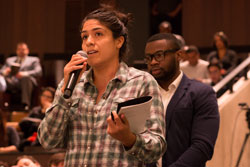 Chris Magnus, the Chief of Police in Richmond, California, said his department has also incorporated community policing, focusing on creating a climate of respect. He said the department doesn’t allow officers to stop-and-frisk — and they not only encourage officers to build relationships in the community, they evaluate them on it.
Chris Magnus, the Chief of Police in Richmond, California, said his department has also incorporated community policing, focusing on creating a climate of respect. He said the department doesn’t allow officers to stop-and-frisk — and they not only encourage officers to build relationships in the community, they evaluate them on it.
“You have to reward those kinds of outcomes,” he said. “We evaluate officers on the kinds of relationships they build with neighborhood groups, associations, schools, and churches, which many of them are regular guests at. They are expected to identify what kinds of problems the community sees as an issue and work with them to solve those problems. Some are easily solved; some are more long term.”
In one particularly tough neighborhood, whose residents had been marginalized, Magnus said he had assumed their biggest concern would be homicides. But when the police stopped to listen, they realized that the big concern was abandoned cars.
“We had 6,000 abandoned cars on the streets in Richmond, and to them, those abandoned cars were a sign of a city government that was ignoring something that affected their quality of life on a day-to-day basis,” he said. “So one of the things we did was get rid of all those cars.”
The officers also focused on engaging with people in truly friendly, positive ways.
“There are a lot of officers who really don’t know how to talk to people,” he said. “They learn in the police academy how to talk at people and give commands to people, but they don’t know how to engage in a friendly conversation with people. And that’s a skill set, and (we can teach) police to do this better. Most officers do want that training … they want to do their jobs better.”
While the conference organizers welcomed the various suggestions for "procedural justice" initiatives and better training that emerged over the two days of discussion, they stressed, as Kalven put it, "the priority of accountability."
So long as abusive officers can operate with impunity, said Futterman, "sensible, well-conceived community policing strategies will be undermined, if not altogether subverted. There is no way around it: meaningful accountability is a necessary condition for building the trust between communities and the police upon which both public safety and effective law enforcement depend."
